Back to Journals » Journal of Pain Research » Volume 15
Publication Trends and Hot Spots in Subacromial Impingement Syndrome Research: A Bibliometric Analysis of the Web of Science Core Collection
Authors Ge M, Zhang Y, Li Y, Feng C, Tian J, Huang Y, Zhao T
Received 9 November 2021
Accepted for publication 12 March 2022
Published 28 March 2022 Volume 2022:15 Pages 837—856
DOI https://doi.org/10.2147/JPR.S348528
Checked for plagiarism Yes
Review by Single anonymous peer review
Peer reviewer comments 3
Editor who approved publication: Dr Houman Danesh
Meng Ge,1,2,* Yuan Zhang,2,3,* Yanlei Li,1,2,* Chenchen Feng,1,2,* Jinlong Tian,1,2 Yazeng Huang,1,2 Tingxiao Zhao1
1Center for Plastic & Reconstructive Surgery, Department of Orthopedics, Zhejiang Provincial People’s Hospital (Affiliated People’s Hospital, Hangzhou Medical College), Hangzhou, Zhejiang, 310014, People’s Republic of China; 2Bengbu Medical College, Bengbu, People’s Republic of China; 3Center for General Practice Medicine, Department of Rheumatology and Immunology, Zhejiang Provincial People’s Hospital (Affiliated People’s Hospital, Hangzhou Medical College), Hangzhou, Zhejiang, 310014, People’s Republic of China
*These authors contributed equally to this work
Correspondence: Tingxiao Zhao; Yazeng Huang, Center for Plastic & Reconstructive Surgery, Department of Orthopedics, Zhejiang Provincial People’s Hospital (Affiliated People’s Hospital, Hangzhou Medical College), Shangtang Road 158#, Hangzhou, Zhejiang, 310014, People’s Republic of China, Email [email protected]; [email protected]
Background: In recent years, the research on subacromial impingement syndrome (SIS) has gradually increased. Although the research directions are diverse, the overall research status and trend are not clear.
Objective: The aim of our study was to use bibliometric analysis to identify the trends in SIS-related research and to analyze the most highly cited scientific publications on SIS.
Methods: All data were retrieved from the Web of Science Core Collection database, and the year of publications, countries, journals, institutions and total number of citations were extracted and analyzed. The results related to countries, institutions and keywords were then analyzed using VOSviewer software and bibliometrics online analysis platform. And, we also identified the 100 most cited articles on SIS.
Results: A total of 548 articles related to AIS were identified. The frequency of publication on SIS has increased substantially over time. Among all countries, Turkey has contributed the most publications on SIS (n=118). The institution with the most articles was Istanbul University (n=17). Journal of Shoulder and Elbow Surgery topped the list of journals and has published 19 SIS-related publications. The hotspot of research changed from the former arthroscopic surgery to physical therapy and rehabilitation.
Conclusion: The scientific research on SIS has rapidly expanded in recent years. This study represents the first bibliometric analysis of SIS, gives us a systematic and comprehensive summary into the development of SIS.
Keywords: subacromial impingement syndrome, SIS, bibliometric analysis, research trends, VOSviewer, Web of Science
Introduction
Shoulder pain occupies a large portion of the orthopedic field, ranking third in musculoskeletal pain.1 Subacromial impingement syndrome (SIS) is the most common cause of shoulder pain, accounting for 44% to 65% of all complaints of shoulder pain lesions, with the age of onset mostly in the 40s and 50s.2–5 In 1972, Neer first proposed the concept of SIS and explained it in detail5. The main pathological mechanism of SIS is structural narrowing of the subacromial space, and its etiology includes a spectrum of disorders ranging from subacromial bursitis and rotator cuff tendinopathy to partial and total rotator cuff tears.6–8
The main clinical manifestations are upper arm supination, abduction, pain after internal rotation, decreased mobility, and loss or diminished arm strength and function.9–12 Because of the diverse and complex etiology of SIS, a thorough history and physical examination, combined with appropriate imaging, are required for a definitive diagnosis, including Neer’s sign, Hawkins-Kennedy sign, and pain arc sign.13,14 Some studies have also used “shoulder arthroscopy” as the “gold standard” for the diagnosis of SIS, but because of its invasive nature it is often used for surgical treatment rather than as a routine preoperative examination.15–17 The treatment of SIS is aimed at reducing pain and restoring function of the shoulder joint. Conservative treatment includes functional exercises, medication, closure therapy, the use of osteo-biological materials and injection therapy. Unlike conventional injection therapy, some scholars have also noted that simultaneous corticosteroid injection into the subacromial bursa and the long head of the biceps tendon sheath is safe and effective, While ensuring short-term efficacy, it also prolongs the duration of symptom relief. Surgical treatment includes traditional open surgery and arthroscopic surgery.18–24
Up to now, research on SIS has expanded dramatically to include study of its pathogenesis, clinical manifestations, radiological evaluation, and surgical and physical treatments, and a large number of SIS publications have been published annually.25–28 In recent years, bibliometric analysis as a reliable statistical method to quantitatively and qualitatively assess research status and trends in a field of study. This analysis method has been widely used in the orthopedic field.29–31 However, To the best of our knowledge, up to date, there is no targeted bibliometric analysis of global scientific research of SIS. Thus, the aim of the current study was to conduct a bibliometric study to summarize and analyses the progress and trends of SIS.
Materials and Methods
Search Strategy
All data for this study were obtained from articles indexed in the Web of Science Core Collection database. The search was conducted on June 25, 2021. The search strategy was as follows: Title = (subacromial impingement syndrome OR shoulder impingement syndrome OR impingement syndrome of the shoulder OR acromion impingement syndrome) AND Title = SIS AND Document type (article OR review) AND Language = English AND Time span = 1900 to 2021.
Tools
VOSviewer, bibliometrics online analysis platform and Microsoft Excel 2016 were used to analyze the data. VOSviewer is a software tool based on Java that assists with visualization and analysis of bibliometric data. We used this software and bibliometrics online analysis platform to visualize networks of authors, countries, institutions, co-citation of references, and co-occurrence of keywords.
Data Extraction
After devising the search strategy, 2 authors (G.M. and Z.T.X.) extracted the articles and bibliometric indicators independently, and the differences were discussed until consensus was achieved. All data were downloaded from the Web of Science Core Collection database, and VOSviewer and Microsoft Excel 2016 were used to extract and analyze article data, including authors, journals, institutions, countries, total citations, and research trends.
Result
Publication Trend
A total of 548 articles on SIS research were identified in the Web of Science Core Collection database. (Supplement Table 1) A trend toward an increasing number of publications between 1972 and 2021 was noted (Figure 1A). Quantitative analysis revealed that global research on SIS has rapidly increased in the past 20 years, with publications increasing rapidly from 80 between 2006 and 2010 to 157 between 2011 and 2015. This indicates that SIS has received increasing attention, and further research on SIS is ongoing.
Country Distribution
The publications were drawn from 48 different countries. Among these countries, the Turkey published the largest number of publications (n=118), followed by United States (n=100), United Kingdom (n=47), Germany (n=27) and Brazil (n=25) (Figure 1B and C). The VOSviewer software was used to analyze the network visualization of co-authorship relationships between countries. The visual analysis shows that the Turkey has always been the center of SIS research in the world, and United States, United Kingdom, Germany, and Brazil have been found to be potential research powers. (Figure 1D).
Institution Distribution
A total of 726 institutions were represented in the published papers. The top 10 institutions were Istanbul University (Turkey; n=17), Hacettepe University (Turkey; n=15), Keele University (United Kingdom; n=14), Virginia Commonwealth University (United States; n=10), Aarhus University Hospital (Denmark; n=9), Federal University of Sao Carlos (Brazil; n=8), University Laval (Canada; n=7), Dokuz Eylul University (Germany; n=7), Baskent University (Turkey; n=7), University of Oregon (United States; n=6), National Taiwan University (Republic of China; n=6), and Marmora university (Canada; n=6) (Figure 2A). Publications from Virginia Commonwealth university were cited the most, with a total of 1003 times, followed by The University of Oregon with 932 citations and Arcadia University with 917 citations (Figure 2B).
With respect to co-authorship relationships between institutions examined in our network visualization analysis, Virginia Commonwealth University had the highest total link strength (n=471), followed by Arcadia University (n=423), The University of Oregon (n=420) and Keele University (n=326). In this analysis, the thickness of the line reflects the frequency of co-authorship collaboration among the institutions. Only institutions with a minimum of 13 articles were included, and a total of 65 institutions met this threshold. Hacettepe University had closely collaborations with Baskent University and National Taiwan University. Pittsburgh University had massive collaborations with Duke University, Texas Scottish Rite Hospital for Children and Pain Relief & Physical Therapy (Figure 2C).
Journal of Publication
The 548 publications were published in 215 academic journals. The top 20 Journals published 40.1% of all publications (Table 1). The top 3 journals were: Journal of Shoulder and Elbow Surgery, Bone and Joint Surgery-American Volume, BMC Musculoskeletal Disorders. Journal of Bone and Joint Surgery-American Volume had the highest number of citations. The Journals with more than 10 of the publications on SIS, mean impact factor (IF) was 4.604, indicating that the included studies were highly reliable.
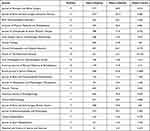 |
Table 1 Journals Publishing Most on Subacromial Impingement Syndrome |
Keywords Analysis and Research Interest
Keywords from publications on SIS research were analyzed using a co-occurrence network analysis tool in the VOSviewer software. In this analysis, the minimum number of occurrences of a key word in publication was set at 15. A total of 48 keywords were identified, and classified into 3 clusters: “Treatment,” “Symptoms,” and “Diagnosis,”. In the treatment cluster, the most popular keywords were “acromioplasty,” “arthroscopic surgery,” and “decompression.” In the symptoms cluster, the most popular keywords were “arm,” “exercise,” “kinematics,” and “manual therapy,” In the Diagnosis cluster, the most popular keywords were “corticosteroid injectoir,” “disability,” “double-blind,” and “efficacy.” (Figure 3A)
To further understand the dynamic change of research topic, we evaluated the evolution of the top most frequent key words in the periods (Figure 3B). Colors were assigned according to the average year in which keywords appeared in articles. For instance, purple keywords appeared earlier than yellow keywords. In the early stage of SIS research, the “rotator cuff,” “rehabilitation,” “arthroscopic surgery” and “acromioplasty,” were the main hotspots. Recent trends showed that the words “exercise,” “pain,” “manual therapy,” and “physiotheraphy” increased in popularity.
The 100 Most-Cited Articles
The top 100 most-cited publications on SIS identified in our study were published between 1972 and 2021 (Table 2).5–7,9,10,12,14,15,18,19,21,22,32–119 The publishing period responsible for the largest number of these studies was 2006 to 2010 with 26 articles, followed by 2011 to 2015 with 25 articles (Figure 4A).
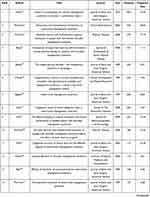 | 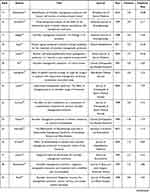 | 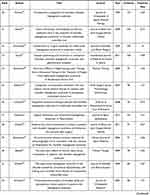 | 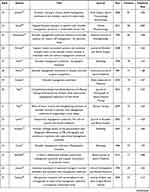 | 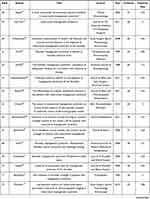 | 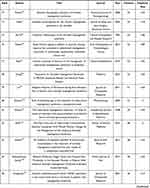 | 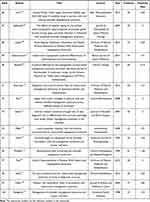 |
Table 2 The Top 100 Most-Cited Articles on Subacromial Impingement Syndrome |
Twenty-two different countries were identified as origins of these 100 publications, authors from the United States contributed to 39 articles, followed by United Kingdom with 9 articles, Canada with 7 articles, Turkey with 6 articles, Germany with 5 articles, Netherlands with 4 articles, Sweden with 4 articles, Finland, Brazil, and China with 3 articles, respectively (Figure 4B).
The Chelsea & Westminster Hospital contributed 4 publications out of the 100, the highest among the institutions represented, followed by Arcadia University with 3 articles (Figure 4C).
Overall, 45 different journals were represented on the list of the 100 most cited publications. Journal of Bone and Joint Surgery-American Volume was the most popular journal, which was responsible for 9 articles and 2737 total citations. This was followed by Journal of Shoulder and Elbow Surgery with 8 articles and 603 total citations. American Journal of Roentgenology, Clinical Orthopaedics and Related Research, and Journal of Orthopaedic & Sports Physical Therapy with 6 articles. (Table 3).
 |
Table 3 Top 5 Journals Publishing the 100 Most-Cited Articles on Subacromial Impingement Syndrome |
With respect to authorship, Michener, L. A. contributed 6 articles, followed by Karduna, A. R. with 4 articles, Lewis, J. S., and Timmons, M. K. with 3 articles respectively (Table 4).
 |
Table 4 Top 4 Authors Contributing to the 100 Most-Cited Articles on Subacromial Impingement Syndrome |
The most common research focuses were Physical Examination (25 articles), followed by Conservative Treatment and Clinical Description (18 articles) Imaging Findings (11 articles), Diagnosis (9 articles) (Figure 4D).
Discussion
Subacromial impingement syndrome is one of the most common causes of shoulder pain and is associated with a large number of shoulder injuries.1–3 Patients often suffer from pain that severely affects the function of the shoulder joint and can even lead to disability, which shows that research on subacromial impingement syndrome is crucial.4–7 Currently, research on SIS has expanded dramatically to include study of its pathology, clinical presentation, natural history, radiological evaluation, and management, and a large number of SIS publications have been published annually. Although the number of studies was sizable, a vacancy of integral analysis of research hot spots is imminent. Therefore, we used bibliometric mapping in the present study to achieve the visualization of the analysis results of SIS research from 1972 to 2021. The VOSviewer, bibliometrics online analysis platform and Microsoft Excel 2016 were used to carry out our survey. This study intuitively showed the research framework, overall knowledge structure, research hotpot, and development trends of the field of SIS, through integrated analysis of the content and external features of research literature. Hopefully, this study will help scientific researchers and surgeon better understand the research status and trends, determine future research direction.
Publication Trends in the SIS Scientific Literature
There has been a rapid growth in SIS-related publications in the last 20 years. The total publications of Turkey and citations of United States ranked first of all the countries, suggesting that Turkey and United States dominates studies of SIS. With respect to institutional contributions, Istanbul University published the most contributing 17 articles and Virginia Commonwealth university ranked first in the total citations, reflecting both the importance and leading role of the institutions in SIS.
Journal of Bone and Joint Surgery-American Volume, Journal of Shoulder and Elbow Surgery, American Journal of Roentgenology, Clinical Orthopaedics and Related Research and Journal of Orthopaedic & Sports Physical Therapy are the top 5 productive journals on SIS, indicating that there will be more high-quality publications on this topic to be published on these journals. Authors interested in SIS research should pay more attention to these journals.
Research Focuses
Keyword analysis results indicated the shoulder pain, rotator cuff injury, rehabilitation, and exercise were the clustering centers of keywords, and the research hotspots gradually changed with the progress of time, from the initial surgical treatment and injury mechanism to conservative treatment and patient prognosis. For example, the early keywords appearing more often are arthoscopic surgery, acromioplasty, rotator cuff tears, while the recent keywords are mostly manual therapy, exercise, corticosteroid injection, disability, and efficacy.
The Most Influential Articles
The most cited publication in SIS was the classic 1972 paper in the American Volume of Journal of Bone and Joint Surgery by Neer5 “Anterior acromioplasty for the chronic impingement syndrome in the shoulder: a preliminary report,” that first introduced the concept of anterior impingement syndrome, repeated impingement of the greater tuberosity of the humerus with the rostral shoulder arch during shoulder pronation and abduction, resulting in subacromial bursa inflammation, rotator cuff tissue degeneration, or even tearing, causing shoulder pain and impaired mobility, which is a general term for anterior or anterolateral superior shoulder pain caused by a combination of factors alone or in combination. In this article, they detail the anatomical findings and rationale, indications, techniques and preliminary results related to anterior capsuloplasty performed since 1965 at the Columbia University College of Physicians and Surgeons and New York Orthopaedic Hospital.
A study published by Michener et al from 2003 was the second most-cited article.6 In this study, they detailed the anatomy of subacromial impingement syndrome, which they found to be the most common cause of shoulder pain, with altered glenohumeral and scapular kinematics, increased anterior and superior displacement of the humeral head and decreased posterior tilt, external rotation and superior rotation. Weakness or fatigue of the muscles controlling these joints, increased flexion of the thoracic and cervical spine, and altered shoulder and lumbar posture have also been shown to be present in patients with SIS. Thus, they point out that postural, kinematic and muscular changes can directly or indirectly alter the dimensions of the subacromial space and the relationship to structures within the subacromial space. Changes in these relationships can also be brought about by architectural deviations in the boundaries of the subacromial space. These multiple factors usually appear in some combination, rather than as a single factor appearing alone. They also look to the future, all patients with SIS should be evaluated for a combination of all anatomical and biomechanical factors in order to design a treatment plan with the best chance of success, and future research needs to further elucidate the mechanisms of SIS and the relationships between the multiple factors implicated in this disorder.
“Shoulder function and 3-dimensional scapular kinematics in people with and without shoulder impingement syndrome” by McClure et al in 2006 was the third most-cited article.7 This purpose of this study was to compare 3-dimensional scapular kinematics, shoulder range of motion, shoulder muscle force, and posture in subjects with and without primary shoulder impingement syndrome. The author recruited Forty-five subjects with impingement syndrome were and compared with 45 subjects without known pathology or impairments matched by age, sex, and hand dominance. They measured shoulder motion and thoracic spine posture and use a dynamometer to measure the force of the muscle. An electromagnetic motion analysis system was used to capture shoulder kinematics during active elevation in both the sagittal and scapular planes as well as during external rotation with the arm at 90 degrees of elevation in the frontal plane. In the end they found Scapular upward rotation and clavicular elevation were slightly greater in the impingement group during flexion and slightly greater posterior scapular tilt and clavicular contraction during scapular plane elevation compared to the control group. The range of motion and force was smaller in all directions in the impingement group compared to the control group. There was no difference in resting position between the two groups.
The most recent publication in our list was by Michener published in 2013 and titled “Supraspinatus tendon and subacromial space parameters measured on ultrasonographic imaging in subacromial impingement syndrome”.18 This study indicates that the supraspinatus tendon is thicker and occupies a greater proportion of the acromiohumeral distance (AHD), supporting an intrinsic mechanism for the etiology of acromioclavicular impingement syndrome. The extrinsic mechanism of tendon compression is also supported theoretically, but future imaging studies will need to confirm direct compression accompanied by elevation. In addition, they found that treatment strategies to reduce tendon thickness could reduce symptoms, and if it can be proven that the pain is indeed caused by tendon compression, surgical intervention to increase subacromial clearance could be considered to achieve a cure.
Limitations
This study provided bibliometric information related to SIS extracted from Web of Science Core Collection database. Although this analysis was relatively comprehensive and objective, it had several limitations. First, some of influential articles that were not included in this database, so they were excluded from our study. Second, our search criteria were limited to articles in English, we might have missed out some of high-impact articles written in other languages.
Conclusion
This bibliometric analysis showed that there is a growing trend both in published articles related to SIS in the last 20 years. Turkey has contributed the most to the SIS literature. Istanbul University, Hacettepe University, Keele University are the top three institutions. Journal of Shoulder and Elbow Surgery, Journal of Bone and Joint Surgery-American Volume, BMC Musculoskeletal Disorders are the top three journals publishing on this topic. Conservative treatment and physical testing have been the focus of recent research. Besides, these 100 most cited papers provide an important reference for future researchers.
Disclosure
The authors report no conflicts of interest in this work.
References
1. Garving C, Jakob S, Bauer I, Nadjar R, Brunner UH. Impingement syndrome of the shoulder. Dtsch Arztebl Int. 2017;114(45):765–776. doi:10.3238/arztebl.2017.0765
2. Kibler WB, Ludewig PM, McClure PW, Michener LA, Bak K, Sciascia AD. Clinical implications of scapular dyskinesis in shoulder injury: the 2013 consensus statement from the ‘Scapular Summit’. Br J Sports Med. 2013;47(14):877–885. doi:10.1136/bjsports-2013-092425
3. Ostör AJ, Richards CA, Prevost AT, Speed CA, Hazleman BL. Diagnosis and relation to general health of shoulder disorders presenting to primary care. Rheumatology (Oxford). 2005;44(6):800–805. doi:10.1093/rheumatology/keh598
4. Urwin M, Symmons D, Allison T, et al. Estimating the burden of musculoskeletal disorders in the community: the comparative prevalence of symptoms at different anatomical sites, and the relation to social deprivation. Ann Rheum Dis. 1998;57(11):649–655. doi:10.1136/ard.57.11.649
5. Neer CS. Anterior acromioplasty for the chronic impingement syndrome in the shoulder. 1972. J Bone Joint Surg Am. 2005;87(6):1399. doi:10.2106/JBJS.8706.cl
6. Michener LA, McClure PW, Karduna AR. Anatomical and biomechanical mechanisms of subacromial impingement syndrome. Clin Biomech (Bristol, Avon). 2003;18(5):369–379. doi:10.1016/s0268-0033(03)00047-0
7. McClure PW, Michener LA, Karduna AR. Shoulder function and 3-dimensional scapular kinematics in people with and without shoulder impingement syndrome. Phys Ther. 2006;86(8):1075–1090. doi:10.1093/ptj/86.8.1075
8. Ludewig PM, Cook TM. Alterations in shoulder kinematics and associated muscle activity in people with symptoms of shoulder impingement. Phys Ther. 2000;80(3):276–291. doi:10.1093/ptj/80.3.276
9. Koester MC, George MS, Kuhn JE. Shoulder impingement syndrome. Am J Med. 2005;118(5):452–455. doi:10.1016/j.amjmed.2005.01.040
10. Harrison AK, Flatow EL. Subacromial impingement syndrome. J Am Acad Orthop Surg. 2011;19(11):701–708. doi:10.5435/00124635-201111000-00006
11. Steenbrink F, de Groot JH, Veeger HE, Meskers CG, van de Sande MA, Rozing PM. Pathological muscle activation patterns in patients with massive rotator cuff tears, with and without subacromial anaesthetics. Man Ther. 2006;11(3):231–237. doi:10.1016/j.math.2006.07.004
12. Park HB, Yokota A, Gill HS, El Rassi G, McFarland EG. Diagnostic accuracy of clinical tests for the different degrees of subacromial impingement syndrome. J Bone Joint Surg Am. 2005;87(7):1446–1455. doi:10.2106/JBJS.D.02335
13. Beaudreuil J, Nizard R, Thomas T, et al. Contribution of clinical tests to the diagnosis of rotator cuff disease: a systematic literature review. Joint Bone Spine. 2009;76(1):15–19. doi:10.1016/j.jbspin.2008.04.015
14. Caliş M, Akgün K, Birtane M, Karacan I, Caliş H, Tüzün F. Diagnostic values of clinical diagnostic tests in subacromial impingement syndrome. Ann Rheum Dis. 2000;59(1):44–47. doi:10.1136/ard.59.1.44
15. Leroux JL, Thomas E, Bonnel F, Blotman F. Diagnostic value of clinical tests for shoulder impingement syndrome. Rev Rhum Engl Ed. 1995;62(6):423–428.
16. MacDonald PB, Clark P, Sutherland K. An analysis of the diagnostic accuracy of the Hawkins and Neer subacromial impingement signs. J Shoulder Elbow Surg. 2000;9(4):299–301. doi:10.1067/mse.2000.106918
17. Ishii D, Kenmoku T, Tazawa R, et al. Limitation of the external glenohumeral joint rotation is associated with subacromial impingement syndrome, especially pain. JSES Int. 2021;5(3):430–438. doi:10.1016/j.jseint.2021.01.015
18. Michener LA, Subasi Yesilyaprak SS, Seitz AL, Timmons MK, Walsworth MK. Supraspinatus tendon and subacromial space parameters measured on ultrasonographic imaging in subacromial impingement syndrome. Knee Surg Sports Traumatol Arthrosc. 2015;23(2):363–369. doi:10.1007/s00167-013-2542-8
19. Gebremariam L, Hay EM, van der Sande R, Rinkel WD, Koes BW, Huisstede BM. Subacromial impingement syndrome–effectiveness of physiotherapy and manual therapy. Br J Sports Med. 2014;48(16):1202–1208. doi:10.1136/bjsports-2012-091802
20. Tahran Ö, Yeşilyaprak SS. Effects of modified posterior shoulder stretching exercises on shoulder mobility, pain, and dysfunction in patients with subacromial impingement syndrome. Sports Health. 2020;12(2):139–148. doi:10.1177/1941738119900532
21. Ellenbecker TS, Cools A. Rehabilitation of shoulder impingement syndrome and rotator cuff injuries: an evidence-based review. Br J Sports Med. 2010;44(5):319–327. doi:10.1136/bjsm.2009.058875
22. Holmgren T, Björnsson Hallgren H, Öberg B, Adolfsson L, Johansson K. Effect of specific exercise strategy on need for surgery in patients with subacromial impingement syndrome: randomised controlled study. BMJ. 2012;344:e787. doi:10.1136/bmj.e787
23. Hsu PC, Chang KV, Wu WT, Wang JC, Özçakar L. Effects of ultrasound-guided peritendinous and intrabursal corticosteroid injections on shoulder tendon elasticity: a post hoc analysis of a randomized controlled trial. Arch Phys Med Rehabil. 2021;102(5):905–913. doi:10.1016/j.apmr.2020.11.011
24. Wang JC, Chang KV, Wu WT, Han DS, Özçakar L. Ultrasound-guided standard vs dual-target subacromial corticosteroid injections for shoulder impingement syndrome: a randomized controlled trial. Arch Phys Med Rehabil. 2019;100(11):2119–2128. doi:10.1016/j.apmr.2019.04.016
25. Paavola M, Kanto K, Ranstam J, et al. Subacromial decompression versus diagnostic arthroscopy for shoulder impingement: a 5-year follow-up of a randomised, placebo surgery controlled clinical trial. Br J Sports Med. 2021;55(2):99–107. doi:10.1136/bjsports-2020-102216
26. Oppong R, Jowett S, Lewis M, et al. The cost-effectiveness of different approaches to exercise and corticosteroid injection for subacromial pain (impingement) syndrome. Rheumatology (Oxford). 2021;60(9):4175–4184. doi:10.1093/rheumatology/keaa903
27. Desmeules F, Côté CH, Frémont P. Therapeutic exercise and orthopedic manual therapy for impingement syndrome: a systematic review. Clin J Sport Med. 2003;13(3):176–182. doi:10.1097/00042752-200305000-00009
28. Hunter DJ, Rivett DA, McKeirnan S, Smith L, Snodgrass SJ. Relationship between shoulder impingement syndrome and thoracic posture. Phys Ther. 2020;100(4):677–686. doi:10.1093/ptj/pzz182
29. Zhao T, Shen J, Zhang J, et al. Top 100 cited articles on spinal disc arthroplasty research. Spine (Phila Pa 1976). 2020;45(21):1530–1536. doi:10.1097/BRS.0000000000003608
30. Tao L, Zhou S, Tao Z, et al. The publication trends and hot spots of scoliosis research from 2009 to 2018: a 10-year bibliometric analysis. Ann Transl Med. 2020;8(6):365. doi:10.21037/atm.2020.02.67
31. Huang Y, Zhao T, Reidler JS, et al. The top 100 most-cited articles on kyphoplasty and vertebroplasty. World Neurosurg. 2020;135:e435–e446. doi:10.1016/j.wneu.2019.12.014
32. Neer CS. Anterior acromioplasty for the chronic impingement syndrome in the shoulder: a preliminary report. J Bone Joint Surg Am. 1972;54(1):41–50. doi:10.2106/00004623-197254010-00003
33. Bang MD, Deyle GD. Comparison of supervised exercise with and without manual physical therapy for patients with shoulder impingement syndrome. J Orthop Sports Phys Ther. 2000;30(3):126–137. doi:10.2519/jospt.2000.30.3.126
34. Bayley JC, Cochran TP, Sledge CB. The weight-bearing shoulder. The impingement syndrome in paraplegics. J Bone Joint Surg Am. 1987;69(5):676–678. doi:10.2106/00004623-198769050-00006
35. Warner JJ, Micheli LJ, Arslanian LE, Kennedy J, Kennedy R. Scapulothoracic motion in normal shoulders and shoulders with glenohumeral instability and impingement syndrome. A study using Moiré topographic analysis. Clin Orthop Relat Res. 1992;285:191–199. doi:10.1097/00003086-199212000-00024
36. Harrison AK, Flatow EL, Bigliani LU, Levine WN. Subacromial impingement syndrome. J Bone Joint Surg Am. 1997;79(12):1854–1868. doi:10.2106/00004623-199712000-00012
37. Hsu YH, Chen WY, Lin HC, Wang WT, Shih YF. The effects of taping on scapular kinematics and muscle performance in baseball players with shoulder impingement syndrome. J Electromyogr Kinesiol. 2009;19(6):1092–1099. doi:10.1016/j.jelekin.2008.11.003
38. McClure PW, Bialker J, Neff N, Williams G, Karduna A. Shoulder function and 3-dimensional kinematics in people with shoulder impingement syndrome before and after a 6-week exercise program. Phys Ther. 2004;84(9):832–848. doi:10.1093/ptj/84.9.832
39. Hébert LJ, Moffet H, McFadyen BJ, Dionne CE. Scapular behavior in shoulder impingement syndrome. Arch Phys Med Rehabil. 2002;83(1):60–69. doi:10.1053/apmr.2002.27471
40. Blair B, Rokito AS, Cuomo F, Jarolem K, Zuckerman JD. Efficacy of injections of corticosteroids for subacromial impingement syndrome. J Bone Joint Surg Am. 1996;78(11):1685–1689. doi:10.2106/00004623-199611000-00007
41. Morrison DS, Frogameni AD, Woodworth P. Non-operative treatment of subacromial impingement syndrome. J Bone Joint Surg Am. 1997;79(5):732–737. doi:10.2106/00004623-199705000-00013
42. Graichen H, Bonel H, Stammberger T, et al. Three-dimensional analysis of the width of the subacromial space in healthy subjects and patients with impingement syndrome. AJR Am J Roentgenol. 1999;172(4):1081–1086. doi:10.2214/ajr.172.4.10587151
43. Seeger LL, Gold RH, Bassett LW, Ellman H. Shoulder impingement syndrome: MR findings in 53 shoulders. AJR Am J Roentgenol. 1988;150(2):343–347. doi:10.2214/ajr.150.2.343
44. Kaya E, Zinnuroglu M, Tugcu I. Kinesio taping compared to physical therapy modalities for the treatment of shoulder impingement syndrome. Clin Rheumatol. 2011;30(2):201–207. doi:10.1007/s10067-010-1475-6
45. Lewis JS. Rotator cuff tendinopathy/subacromial impingement syndrome: is it time for a new method of assessment? Br J Sports Med. 2009;43(4):259–264. doi:10.1136/bjsm.2008.052183
46. Fu FH, Harner CD, Klein AH. Shoulder impingement syndrome. A critical review. Clin Orthop Relat Res. 1991;269:162–173. doi:10.1097/00003086-199108000-00024
47. Lewis JS, Wright C, Green A. Subacromial impingement syndrome: the effect of changing posture on shoulder range of movement. J Orthop Sports Phys Ther. 2005;35(2):72–87. doi:10.2519/jospt.2005.35.2.72
48. Conroy DE, Hayes KW. The effect of joint mobilization as a component of comprehensive treatment for primary shoulder impingement syndrome. J Orthop Sports Phys Ther. 1998;28(1):3–14. doi:10.2519/jospt.1998.28.1.3
49. Tibone JE, Jobe FW, Kerlan RK, et al. Shoulder impingement syndrome in athletes treated by an anterior acromioplasty. Clin Orthop Relat Res. 1985;198:134–140. doi:10.1097/00003086-198509000-00020
50. Hanratty CE, McVeigh JG, Kerr DP, et al. The effectiveness of physiotherapy exercises in subacromial impingement syndrome: a systematic review and meta-analysis. Semin Arthritis Rheum. 2012;42(3):297–316. doi:10.1016/j.semarthrit.2012.03.015
51. Kromer TO, Tautenhahn UG, de Bie RA, Staal JB, Bastiaenen CH. Effects of physiotherapy in patients with shoulder impingement syndrome: a systematic review of the literature. J Rehabil Med. 2009;41(11):870–880. doi:10.2340/16501977-0453
52. Rockwood CA, Lyons FR. Shoulder impingement syndrome: diagnosis, radiographic evaluation, and treatment with a modified Neer acromioplasty. J Bone Joint Surg Am. 1993;75(3):409–424. doi:10.2106/00004623-199303000-00013
53. Read JW, Perko M. Shoulder ultrasound: diagnostic accuracy for impingement syndrome, rotator cuff tear, and biceps tendon pathology. J Shoulder Elbow Surg. 1998;7(3):264–271. doi:10.1016/s1058-2746(98)90055-6
54. Kamkar A, Irrgang JJ, Whitney SL. Nonoperative management of secondary shoulder impingement syndrome. J Orthop Sports Phys Ther. 1993;17(5):212–224. doi:10.2519/jospt.1993.17.5.212
55. Ketola S, Lehtinen J, Arnala I, et al. Does arthroscopic acromioplasty provide any additional value in the treatment of shoulder impingement syndrome?: a two-year randomised controlled trial. J Bone Joint Surg Br. 2009;91(10):1326–1334. doi:10.1302/0301-620X.91B10.22094
56. Dorrestijn O, Stevens M, Winters JC, van der Meer K, Diercks RL. Conservative or surgical treatment for subacromial impingement syndrome? A systematic review. J Shoulder Elbow Surg. 2009;18(4):652–660. doi:10.1016/j.jse.2009.01.010
57. Struyf F, Nijs J, Baeyens JP, Mottram S, Meeusen R. Scapular positioning and movement in unimpaired shoulders, shoulder impingement syndrome, and glenohumeral instability. Scand J Med Sci Sports. 2011;21(3):352–358. doi:10.1111/j.1600-0838.2010.01274.x
58. Santamato A, Solfrizzi V, Panza F, et al. Short-term effects of high-intensity laser therapy versus ultrasound therapy in the treatment of people with subacromial impingement syndrome: a randomized clinical trial [published correction appears in Phys Ther. 2009 Sep;89(9):999]. Phys Ther. 2009;89(7):643–652. doi:10.2522/ptj.20080139
59. Senbursa G, Baltaci G, Atay A. Comparison of conservative treatment with and without manual physical therapy for patients with shoulder impingement syndrome: a prospective, randomized clinical trial. Knee Surg Sports Traumatol Arthrosc. 2007;15(7):915–921. doi:10.1007/s00167-007-0288-x
60. Lombardi I, Magri AG, Fleury AM, Da Silva AC, Natour J. Progressive resistance training in patients with shoulder impingement syndrome: a randomized controlled trial. Arthritis Rheum. 2008;59(5):615–622. doi:10.1002/art.23576
61. Timmons MK, Thigpen CA, Seitz AL, Karduna AR, Arnold BL, Michener LA. Scapular kinematics and subacromial-impingement syndrome: a meta-analysis. J Sport Rehabil. 2012;21(4):354–370. doi:10.1123/jsr.21.4.354
62. Gwilym SE, Oag HC, Tracey I, Carr AJ. Evidence that central sensitisation is present in patients with shoulder impingement syndrome and influences the outcome after surgery. J Bone Joint Surg Br. 2011;93(4):498–502. doi:10.1302/0301-620X.93B4.25054
63. Desmeules F, Minville L, Riederer B, Côté CH, Frémont P. Acromio-humeral distance variation measured by ultrasonography and its association with the outcome of rehabilitation for shoulder impingement syndrome. Clin J Sport Med. 2004;14(4):197–205. doi:10.1097/00042752-200407000-00002
64. Boyles RE, Ritland BM, Miracle BM, et al. The short-term effects of thoracic spine thrust manipulation on patients with shoulder impingement syndrome. Man Ther. 2009;14(4):375–380. doi:10.1016/j.math.2008.05.005
65. Walther M, Werner A, Stahlschmidt T, Woelfel R, Gohlke F. The subacromial impingement syndrome of the shoulder treated by conventional physiotherapy, self-training, and a shoulder brace: results of a prospective, randomized study. J Shoulder Elbow Surg. 2004;13(4):417–423. doi:10.1016/j.jse.2004.02.002
66. Graichen H, Stammberger T, Bonél H, et al. Three-dimensional analysis of shoulder girdle and supraspinatus motion patterns in patients with impingement syndrome. J Orthop Res. 2001;19(6):1192–1198. doi:10.1016/S0736-0266(01)00035-3
67. Jonsson P, Wahlström P, Ohberg L, Alfredson H. Eccentric training in chronic painful impingement syndrome of the shoulder: results of a pilot study. Knee Surg Sports Traumatol Arthrosc. 2006;14(1):76–81. doi:10.1007/s00167-004-0611-8
68. Struyf F, Nijs J, Mollekens S, et al. Scapular-focused treatment in patients with shoulder impingement syndrome: a randomized clinical trial. Clin Rheumatol. 2013;32(1):73–85. doi:10.1007/s10067-012-2093-2
69. Brossmann J, Preidler KW, Pedowitz RA, White LM, Trudell D, Resnick D. Shoulder impingement syndrome: influence of shoulder position on rotator cuff impingement–an anatomic study. AJR Am J Roentgenol. 1996;167(6):1511–1515. doi:10.2214/ajr.167.6.8956588
70. Moraes GF, Faria CD, Teixeira-Salmela LF. Scapular muscle recruitment patterns and isokinetic strength ratios of the shoulder rotator muscles in individuals with and without impingement syndrome. J Shoulder Elbow Surg. 2008;17(1Suppl):48S–53S. doi:10.1016/j.jse.2007.08.007
71. Farin PU, Jaroma H, Harju A, Soimakallio S. Shoulder impingement syndrome: sonographic evaluation. Radiology. 1990;176(3):845–849. doi:10.1148/radiology.176.3.2202014
72. Penny JN, Welsh RP. Shoulder impingement syndromes in athletes and their surgical management. Am J Sports Med. 1981;9(1):11–15. doi:10.1177/036354658100900102
73. Tate AR, McClure PW, Young IA, Salvatori R, Michener LA. Comprehensive impairment-based exercise and manual therapy intervention for patients with subacromial impingement syndrome: a case series. J Orthop Sports Phys Ther. 2010;40(8):474–493. doi:10.2519/jospt.2010.3223
74. Roy JS, Moffet H, Hébert LJ, Lirette R. Effect of motor control and strengthening exercises on shoulder function in persons with impingement syndrome: a single-subject study design. Man Ther. 2009;14(2):180–188. doi:10.1016/j.math.2008.01.010
75. Lewis JS, Green A, Wright C. Subacromial impingement syndrome: the role of posture and muscle imbalance. J Shoulder Elbow Surg. 2005;14(4):385–392. doi:10.1016/j.jse.2004.08.007
76. Guntern DV, Pfirrmann CW, Schmid MR, et al. Articular cartilage lesions of the glenohumeral joint: diagnostic effectiveness of MR arthrography and prevalence in patients with subacromial impingement syndrome. Radiology. 2003;226(1):165–170. doi:10.1148/radiol.2261012090
77. Cone RO, Resnick D, Danzig L. Shoulder impingement syndrome: radiographic evaluation. Radiology. 1984;150(1):29–33. doi:10.1148/radiology.150.1.6689783
78. Ratcliffe E, Pickering S, McLean S, Lewis J. Is there a relationship between subacromial impingement syndrome and scapular orientation? A systematic review [published correction appears in Br J Sports Med. 2014 Aug;48(16):1396]. Br J Sports Med. 2014;48(16):1251–1256. doi:10.1136/bjsports-2013-092389
79. Leroux JL, Codine P, Thomas E, Pocholle M, Mailhe D, Blotman F. Isokinetic evaluation of rotational strength in normal shoulders and shoulders with impingement syndrome. Clin Orthop Relat Res. 1994;304:108–115. doi:10.1097/00003086-199407000-00018
80. Henkus HE, de Witte PB, Nelissen RG, Brand R, van Arkel ER. Bursectomy compared with acromioplasty in the management of subacromial impingement syndrome: a prospective randomised study. J Bone Joint Surg Br. 2009;91(4):504–510. doi:10.1302/0301-620X.91B4.21442
81. Akgün K, Birtane M, Akarirmak U. Is local subacromial corticosteroid injection beneficial in subacromial impingement syndrome? Clin Rheumatol. 2004;23(6):496–500. doi:10.1007/s10067-004-0930-7
82. Cholewinski JJ, Kusz DJ, Wojciechowski P, Cielinski LS, Zoladz MP. Ultrasound measurement of rotator cuff thickness and acromio-humeral distance in the diagnosis of subacromial impingement syndrome of the shoulder. Knee Surg Sports Traumatol Arthrosc. 2008;16(4):408–414. doi:10.1007/s00167-007-0443-4
83. Frost P, Andersen JH. Shoulder impingement syndrome in relation to shoulder intensive work. Occup Environ Med. 1999;56(7):494–498. doi:10.1136/oem.56.7.494
84. Hardy DC, Vogler JB, White RH. The shoulder impingement syndrome: prevalence of radiographic findings and correlation with response to therapy. AJR Am J Roentgenol. 1986;147(3):557–561. doi:10.2214/ajr.147.3.557
85. Papadonikolakis A, McKenna M, Warme W, Martin BI, Matsen FA. Published evidence relevant to the diagnosis of impingement syndrome of the shoulder. J Bone Joint Surg Am. 2011;93(19):1827–1832. doi:10.2106/JBJS.J.01748
86. Başkurt Z, Başkurt F, Gelecek N, Özkan MH. The effectiveness of scapular stabilization exercise in the patients with subacromial impingement syndrome. J Back Musculoskelet Rehabil. 2011;24(3):173–179. doi:10.3233/BMR-2011-0291
87. Chester R, Smith TO, Hooper L, Dixon J. The impact of subacromial impingement syndrome on muscle activity patterns of the shoulder complex: a systematic review of electromyographic studies. BMC Musculoskelet Disord. 2010;11:45. doi:10.1186/1471-2474-11-45
88. Bernhardsson S, Klintberg IH, Wendt GK. Evaluation of an exercise concept focusing on eccentric strength training of the rotator cuff for patients with subacromial impingement syndrome. Clin Rehabil. 2011;25(1):69–78. doi:10.1177/0269215510376005
89. Bandholm T, Rasmussen L, Aagaard P, Jensen BR, Diederichsen L. Force steadiness, muscle activity, and maximal muscle strength in subjects with subacromial impingement syndrome. Muscle Nerve. 2006;34(5):631–639. doi:10.1002/mus.20636
90. Ardic F, Kahraman Y, Kacar M, Kahraman MC, Findikoglu G, Yorgancioglu ZR. Shoulder impingement syndrome: relationships between clinical, functional, and radiologic findings. Am J Phys Med Rehabil. 2006;85(1):53–60. doi:10.1097/01.phm.0000179518.85484.53
91. Chipchase LS, O’Connor DA, Costi JJ, Krishnan J. Shoulder impingement syndrome: preoperative health status. J Shoulder Elbow Surg. 2000;9(1):12–15. doi:10.1016/s1058-2746(00)90003-x
92. Valadie AL, Jobe CM, Pink MM, Ekman EF, Jobe FW. Anatomy of provocative tests for impingement syndrome of the shoulder. J Shoulder Elbow Surg. 2000;9(1):36–46. doi:10.1016/s1058-2746(00)90008-9
93. Ben-Yishay A, Zuckerman JD, Gallagher M, Cuomo F. Pain inhibition of shoulder strength in patients with impingement syndrome. Orthopedics. 1994;17(8):685–688. doi:10.3928/0147-7447-19940801-06
94. Bureau NJ, Beauchamp M, Cardinal E, Brassard P. Dynamic sonography evaluation of shoulder impingement syndrome. AJR Am J Roentgenol. 2006;187(1):216–220. doi:10.2214/AJR.05.0528
95. Burns WC, Whipple TL. Anatomic relationships in the shoulder impingement syndrome. Clin Orthop Relat Res. 1993;294:96–102. doi:10.1097/00003086-199309000-00012
96. Şimşek HH, Balki S, Keklik SS, Öztürk H, Elden H. Does Kinesio taping in addition to exercise therapy improve the outcomes in subacromial impingement syndrome? A randomized, double-blind, controlled clinical trial. Acta Orthop Traumatol Turc. 2013;47(2):104–110. doi:10.3944/aott.2013.2782
97. Kelly SM, Wrightson PA, Meads CA. Clinical outcomes of exercise in the management of subacromial impingement syndrome: a systematic review. Clin Rehabil. 2010;24(2):99–109. doi:10.1177/0269215509342336
98. Dong W, Goost H, Lin XB, et al. Treatments for shoulder impingement syndrome: a PRISMA systematic review and network meta-analysis [published correction appears in Medicine (Baltimore). 2016 Jun 10;95(23):e96d5]. Medicine (Baltimore). 2015;94(10):e510. doi:10.1097/MD.0000000000000510
99. Lin JJ, Hsieh SC, Cheng WC, Chen WC, Lai Y. Adaptive patterns of movement during arm elevation test in patients with shoulder impingement syndrome. J Orthop Res. 2011;29(5):653–657. doi:10.1002/jor.21300
100. Dickens VA, Williams JL, Bhamra MS. Role of physiotherapy in the treatment of subacromial impingement syndrome: a prospective study. Physiotherapy. 2005;91(3):159–164. doi:10.1016/j.physio.2004.10.008
101. Rahme H, Solem-Bertoft E, Westerberg CE, Lundberg E, Sörensen S, Hilding S. The subacromial impingement syndrome. A study of results of treatment with special emphasis on predictive factors and pain-generating mechanisms. Scand J Rehabil Med. 1998;30(4):253–262. doi:10.1080/003655098444002
102. Rhon DI, Boyles RB, Cleland JA. One-year outcome of subacromial corticosteroid injection compared with manual physical therapy for the management of the unilateral shoulder impingement syndrome: a pragmatic randomized trial. Ann Intern Med. 2014;161(3):161–169. doi:10.7326/M13-2199
103. Ketola S, Lehtinen J, Rousi T, et al. No evidence of long-term benefits of arthroscopic acromioplasty in the treatment of shoulder impingement syndrome: five-year results of a randomised controlled trial. Bone Joint Res. 2013;2(7):132–139. doi:10.1302/2046-3758.27.2000163
104. Alburquerque-Sendín F, Camargo PR, Vieira A, Salvini TF. Bilateral myofascial trigger points and pressure pain thresholds in the shoulder muscles in patients with unilateral shoulder impingement syndrome: a blinded, controlled study. Clin J Pain. 2013;29(6):478–486. doi:10.1097/AJP.0b013e3182652d65
105. Yanagisawa K, Hamada K, Gotoh M, et al. Vascular endothelial growth factor (VEGF) expression in the subacromial bursa is increased in patients with impingement syndrome. J Orthop Res. 2001;19(3):448–455. doi:10.1016/S0736-0266(00)90021-4
106. Tucci HT, Martins J, Sposito Gde C, Camarini PM, de Oliveira AS. Closed Kinetic Chain Upper Extremity Stability test (CKCUES test): a reliability study in persons with and without shoulder impingement syndrome. BMC Musculoskelet Disord. 2014;15:1. doi:10.1186/1471-2474-15-1
107. Selkowitz DM, Chaney C, Stuckey SJ, Vlad G. The effects of scapular taping on the surface electromyographic signal amplitude of shoulder girdle muscles during upper extremity elevation in individuals with suspected shoulder impingement syndrome. J Orthop Sports Phys Ther. 2007;37(11):694–702. doi:10.2519/jospt.2007.2467
108. Lopes AD, Timmons MK, Grover M, Ciconelli RM, Michener LA. Visual scapular dyskinesis: kinematics and muscle activity alterations in patients with subacromial impingement syndrome. Arch Phys Med Rehabil. 2015;96(2):298–306. doi:10.1016/j.apmr.2014.09.029
109. Abdulla SY, Southerst D, Côté P, et al. Is exercise effective for the management of subacromial impingement syndrome and other soft tissue injuries of the shoulder? A systematic review by the Ontario Protocol for Traffic Injury Management (OPTIMa) Collaboration. Man Ther. 2015;20(5):646–656. doi:10.1016/j.math.2015.03.013
110. Alqunaee M, Galvin R, Fahey T. Diagnostic accuracy of clinical tests for subacromial impingement syndrome: a systematic review and meta-analysis. Arch Phys Med Rehabil. 2012;93(2):229–236. doi:10.1016/j.apmr.2011.08.035
111. Roy JS, Moffet H, McFadyen BJ. Upper limb motor strategies in persons with and without shoulder impingement syndrome across different speeds of movement. Clin Biomech (Bristol, Avon). 2008;23(10):1227–1236. doi:10.1016/j.clinbiomech.2008.07.009
112. Zaslav KR. Internal rotation resistance strength test: a new diagnostic test to differentiate intra-articular pathology from outlet (Neer) impingement syndrome in the shoulder. J Shoulder Elbow Surg. 2001;10(1):23–27. doi:10.1067/mse.2001.111960
113. Plafki C, Steffen R, Willburger RE, Wittenberg RH. Local anaesthetic injection with and without corticosteroids for subacromial impingement syndrome. Int Orthop. 2000;24(1):40–42. doi:10.1007/s002640050010
114. Tuite MJ, Toivonen DA, Orwin JF, Wright DH. Acromial angle on radiographs of the shoulder: correlation with the impingement syndrome and rotator cuff tears. AJR Am J Roentgenol. 1995;165(3):609–613. doi:10.2214/ajr.165.3.7645479
115. Wuelker N, Plitz W, Roetman B. Biomechanical data concerning the shoulder impingement syndrome. Clin Orthop Relat Res. 1994;303:242–249. doi:10.1097/00003086-199406000-00033
116. Paul TM, Soo Hoo J, Chae J, Wilson RD. Central hypersensitivity in patients with subacromial impingement syndrome. Arch Phys Med Rehabil. 2012;93(12):2206–2209. doi:10.1016/j.apmr.2012.06.026
117. Kelly SM, Brittle N, Allen GM. The value of physical tests for subacromial impingement syndrome: a study of diagnostic accuracy. Clin Rehabil. 2010;24(2):149–158. doi:10.1177/0269215509346103
118. Myers JB, Hwang JH, Pasquale MR, Blackburn JT, Lephart SM. Rotator cuff coactivation ratios in participants with subacromial impingement syndrome. J Sci Med Sport. 2009;12(6):603–608. doi:10.1016/j.jsams.2008.06.003
119. Fongemie AE, Buss DD, Rolnick SJ. Management of shoulder impingement syndrome and rotator cuff tears. Am Fam Physician. 1998;57(4):667–682.
 © 2022 The Author(s). This work is published and licensed by Dove Medical Press Limited. The full terms of this license are available at https://www.dovepress.com/terms.php and incorporate the Creative Commons Attribution - Non Commercial (unported, v3.0) License.
By accessing the work you hereby accept the Terms. Non-commercial uses of the work are permitted without any further permission from Dove Medical Press Limited, provided the work is properly attributed. For permission for commercial use of this work, please see paragraphs 4.2 and 5 of our Terms.
© 2022 The Author(s). This work is published and licensed by Dove Medical Press Limited. The full terms of this license are available at https://www.dovepress.com/terms.php and incorporate the Creative Commons Attribution - Non Commercial (unported, v3.0) License.
By accessing the work you hereby accept the Terms. Non-commercial uses of the work are permitted without any further permission from Dove Medical Press Limited, provided the work is properly attributed. For permission for commercial use of this work, please see paragraphs 4.2 and 5 of our Terms.




